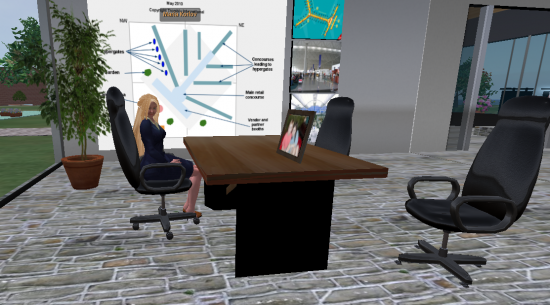I’m ending it.
Beset by criticism on all sides — okay, just one side — I am officially going cold turkey on “real life.”
The phrase, that is, not the living itself.

I’ve never been a big fan of the wording “in real life,” but haven’t noticed to what extent it’s crept into my language until Ron Blechner pointed it out earlier today.
“I would encourage you to stop using the term ‘real life’ in opposition to virtual worlds,” he said. “It implies virtual worlds are fake.”
Virtual worlds are certainly not fake to me — no more than a telephone is fake, or email, or video conferences. Or faxes, back in the days we sent faxes. Are all valid communication mediums, and vital to business success. Well, maybe not the faxes.
As possible replacements to the phrase “real life,” he suggested saying “physical world” or “in person,” or to draw no distinction at all between the physical and virtual environments.
And, since the entire discussion was held on Twitter, others immediately chimed in.
Bernhard Drax, who makes machinima for corporate and non-profit clients, suggested replacing “world” with “realm,” as in the sentence: “I have an appointment in the physical realm before I head back to my virtual office.”

Meadhbh Hamrick, a former Second Life staffer who’s now doing independent consulting work, suggested “embodied reality” instead of “real life” and “emergent reality” to replace “virtual environments.”
Jonas Karlsson, a researcher at Xerox, suggested “avatar-based communication.”
My favorite alternative was Neil Canham’s tongue-in-cheek suggestion to replace “real life” with “mace to face” — possibly referring to virtual worlds in which medieval weaponry is used. Or, possibly, to pepper spray.
But all kidding aside, there’s an important distinction that needs to be drawn in how we use language, especially when we talk about virtual worlds in the context of business applications.
“Words to describe virtual worlds impact how people think and feel about virtual worlds,” said Blechner. “If we put virtual worlds in dichotomy versus ‘real life,’ people think ‘fake’.”

Fortunately, we don’t have to invent new language out of whole cloth.
We already have two examples of virtual communication, and can borrow language from those.
The telephone
A telephone conversation is a very well-known example of a virtual communication — virtual here being used in the broadest sense of the word.
We follow up phone calls with face-to-face meetings. When we meet someone for the first time after talking with them on the phone, we say that it’s nice to finally meet them in person.
Both “face to face” and “in person” are clear, and easy, alternatives to “in real life.”
You would never ask someone on the telephone, “So, what do you do in real life?”
Yes, people might sound different on the telephone than in person — my mother, for example, a Russian immigrant, is a bit scared of the phone, and yells loudly into it when she has to have a phone conversation. But the only time a person on the telephone is likely to use a pseudonym — and use a phrase like “in real life” — is if they’re in the phone sex business.
One significant difference between virtual encounters and telephone conversation, however, is that virtual environments convey a sense of place.
When you ask, “Where are you?” to someone on the telephone, they know you’re talking about their physical location, not their phone number. But this same question has a different meaning in a virtual environment.
Second Life’s casual users and World of Warcraft players would ask, “Where are you in real life?”
But a virtual business meeting is no less “real” than a telephone call or an email discussion, so another phrase is needed to describe location in this context.
Some possibilities:
- Where are you based?
- What city are you in?
- Where’s your office located?
When a business meeting starts to drag on, one participant might say to the others, “Let’s continue this online.”
However, though a virtual world is also “online” in the technical sense, “online” has come to mean email or discussion forums, so it’s not a good fit for virtual environments.
When two Second Life residents want to schedule a virtual meeting, they often say, “let’s meet in-world.” That presupposes that there is one virtual world in which they are meeting. That might be the case of die-hard fans of World of Warcraft or Second Life, but business users are less likely to think of their business grids or collaborative spaces as a “world.”
In fact, some enterprise virtual platforms, like ProtoSphere and Teleplace are not architected as worlds, but as individual rooms, linked together by teleportation portals.
Even when using a platform that has wide-open outdoor spaces, like OpenSim, it’s hard to think of your virtual office as a world. For example, my company’s offices are on a private mini-grid. We teleport via the hypergrid to OSGrid and other public grids when we need to go out for a meeting, networking event, or just to do some shopping. OSGrid feels like a world — and, at 6,000-plus regions, it certainly should. But our private grid doesn’t.
Instead, when we talk about meeting there, we say, “Let’s meet in our virtual office,” or, “Come visit our grid.”
The word “world” has too many connotations — of a place that has its own culture, economy, tourist destinations, shopping centers. Our company grid just has a bunch of offices and project planning boards, and some outdoor seating near a lily pond for al fresco strategizing.
But there is some terminology that we can borrow from the email arena. When an email discussion needs some face-to-face time, someone might say, “Let’s talk further offline. Say, drinks after work?”
The word “offline” is a good fit for when a virtual meeting will transition to a face-to-face one as well. As in, “Let’s continue this offline. How about over coffee, tomorrow morning?”
- Analysts predict drop in headset sales this year - March 25, 2025
- OSgrid enters immediate long-term maintenance - March 5, 2025
- OSgrid wiping its database on March 21: You have five weeks to save your stuff - February 15, 2025
